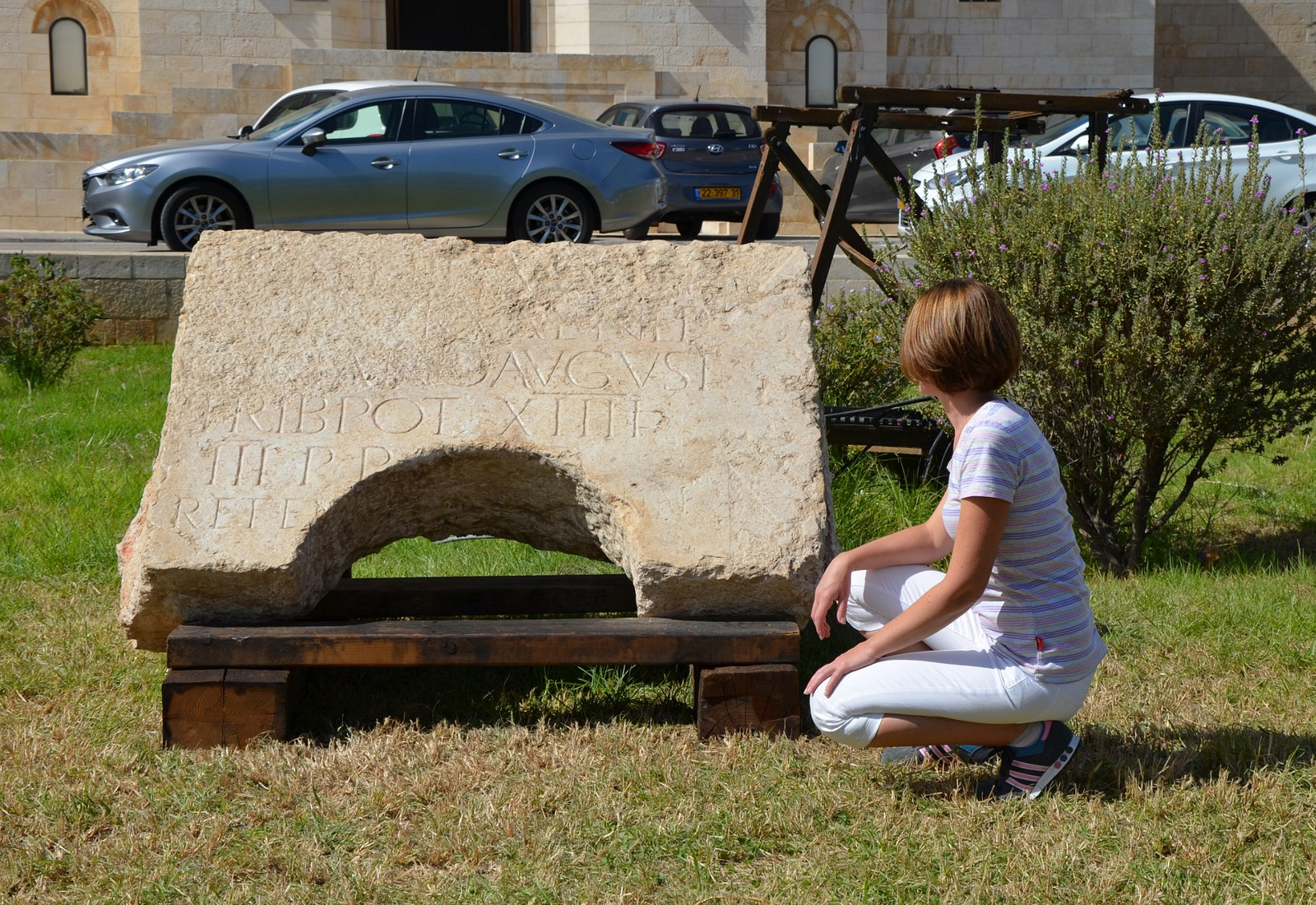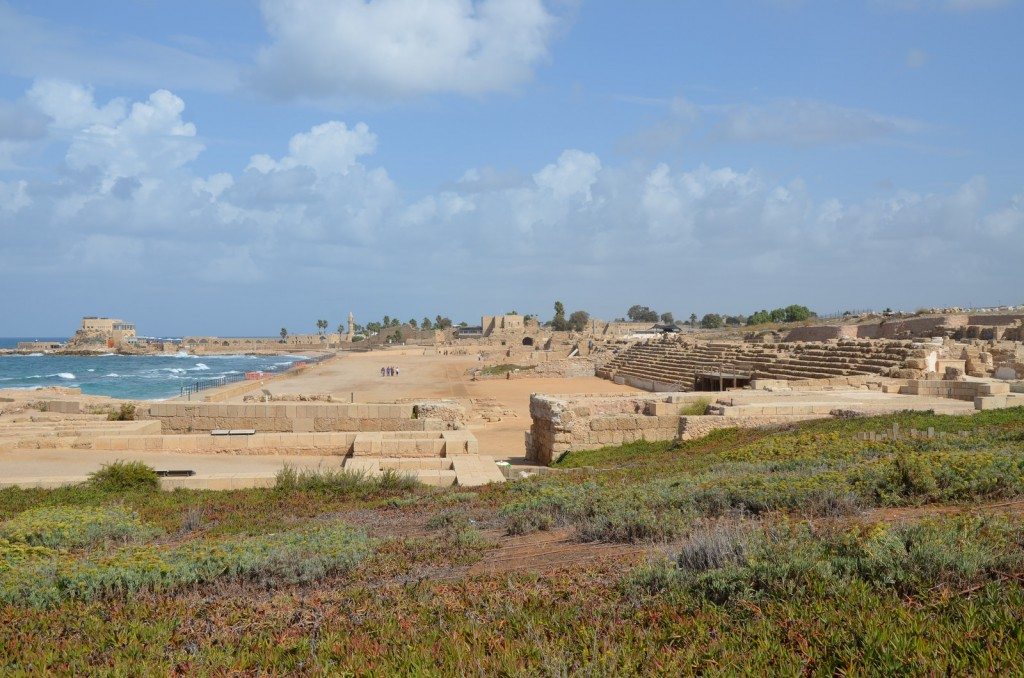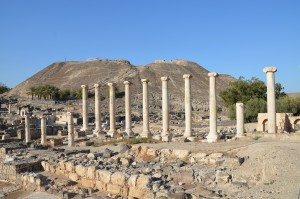On the shores of the Mediterranean sea, Israel is a country with a rich archaeological and religious history. As a land of great significance for Jews, Christians and Muslims, it has many sacred sites like the Church of the Holy Sepulchre, Temple Mount and Al-Aqsa Mosque. People are also drawn to the many ancient relics and landmarks Israel has to offer.
In this interview with Ancient History Encyclopedia, Jade Koekoe speaks to Carole Raddato of Following Hadrian. Carole discusses her recent experiences in Israel and gives her advice about traveling to this magnificent country on a budget.
JK: Welcome to Ancient History Encyclopedia, Carole! It’s an immense pleasure to be working with the author of Following Hadrian blog once again.
How long was your trip and what was your itinerary?
CR: I flew from Frankfurt. When I first looked for flights to Tel Aviv for October 2014 I checked Lufthansa but at the time (March 2014) they were very expensive at €1,200 return per passenger. I then decided to check on skyscanner.net to see if there was a cheaper alternative. I found a flight for €400 return with Pegasus Airlines, a Turkish low-cost airline, with a stopover in Istanbul. The length of our journey to Tel Aviv was twice as long, from four hours to eight hours, but the cost of flying was considerably reduced. Getting to Israel cheaply used to be a challenge but nowadays there are plenty of airlines flying to Tel Aviv including a large number of low-cost European airlines. I am sure there are bargains if you search around, whether you are flying from the US or Europe, just be prepared to fly to Israel on a non-direct flight.
Regarding the itinerary I always use the fabulous Archaeological Atlas of Antiquity website to check all possible ancient sites to visit. I create a map for myself on Google Maps by adding all the archaeological sites I want to visit and I work out the itinerary based on the map. My Israeli itinerary was two nights near Caesarea with day-trips to Sepphoris, Meggido, Beit She’an, Tiberias and the Sea of Galilee, and three nights in Jerusalem with a day-trip to Beit Guvrin and Masada
JK: Which destinations do you suggest visiting in Israel that are affordable and off the beaten path?
CR: Caesarea (the port city built up by Herod the Great and named Caesarea in honour of the emperor Augustus Caesar) is not really off the beaten path but the small site of the Byzantine Bird Mosaic, located outside the walls of the ancient settlement, is easily missed by visitors.
I would also recommend a visit to the site of Sepphoris in the western Lower Galilee (also known as Tzipori) for its wonderful mosaic floors, including the so-called “Mona Lisa of Galilee”, part of a 3rd century CE mosaic floor depicting the life of Dionysus.
I would recommend the site of Tel Megiddo with its 25 layers of occupation dating from the 4th millennium BCE to the 3rd century BCE. The city is referred to as Armageddon, according to the Book of Revelation, this is the place where the last great battle will be fought when the forces of good will triumph over evil. I would also add Beit Guvrin where you can see the best-preserved Roman amphitheatre in Israel as well as the Hellenistic tombs of Sidonian merchants that are painted inside.
These places are easily reached by car from Jerusalem or Tel Aviv. If you don’t rent a car then it will be difficult to visit these places as I don’t think any tour operator offers these destinations as part of their tours/packages. Renting a car in Israel (I recommend rentalcars.com) is an easy way of getting around the country if you are touring archaeological sites, you can go where you want, when you want. Otherwise taxis are widely available (except on Shabbat, from between sunset on Friday and sunset on Saturday).
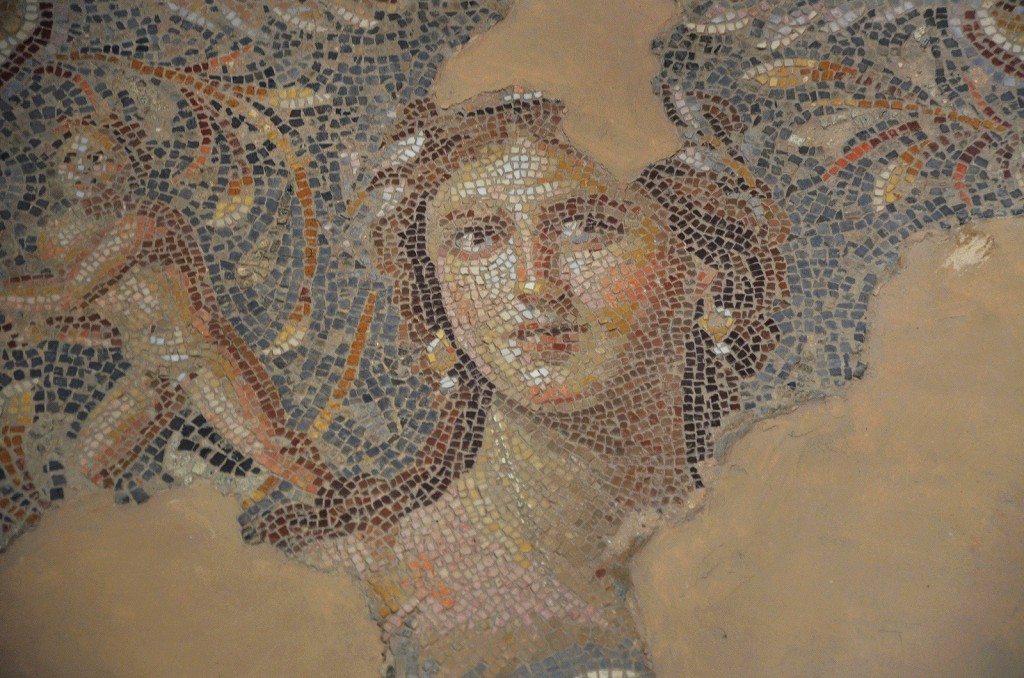
The Mona Lisa of the Galilee (possibly Venus), part of the Dionysus mosaic floor in Sepphoris (Diocaesarea). Photo © Carole Raddato
JK: Though it is a small nation, Israel has a rich culture, excellent cuisine, unique heritage sites and world-class museums. What are your top five sites in Israel that shouldn’t be missed and did you visit them this trip?
CR: These are my top five sites that shouldn’t be missed all of which I got to visit during my trip.
Masada, Jerusalem, Caesarea Maritima, Beit Shean (Scythopolis) and Tel Meggido.
JK: Were you able to visit any ancient sites in the Palestinian Territories?
CR: I have only been to the Israel once but I am already planning another trip as I did not have the time to visit the archaeological sites located in the Palestinian West Bank like Herodium (King Herod’s Palace-Fortress), Samaria (renamed Sebastia by Augustus) and Hippos Sussita.
JK: Near Jerusalem there is the Aelia Capitolina arch, a legacy from the Roman Emperor Hadrian. As you have quite often followed in Hadrian’s footsteps, did you get a chance to see this arch also? How does it compare to arches in other parts of what was the Roman Empire that you have seen?
CR: Yes, of course, I did get the chance to see the arch of Hadrian. The so-called Ecce Homo Arch is located near to the eastern end of the Via Dolorosa. What we see today outside in the street is the central span of what was originally a triple-arched gateway. If you enter the Ecce Homo Church you can also see one of the two smaller arches that flanked the central arch. If you ask nicely the French sisters will gladly take you there. It is said that it was similar in purpose to the Arch of Titus in Rome commemorating the 70 CE victory over the Jews but it may have looked like the Arch of Hadrian in Jerash (Roman Gerasa) in Jordan or the Arch of Septimius Severus in Rome. The Arch of Hadrian in Jerusalem served as the eastern entrance of the Forum of Aelia Capitolina located to the west of the main north-south cardo maximus.
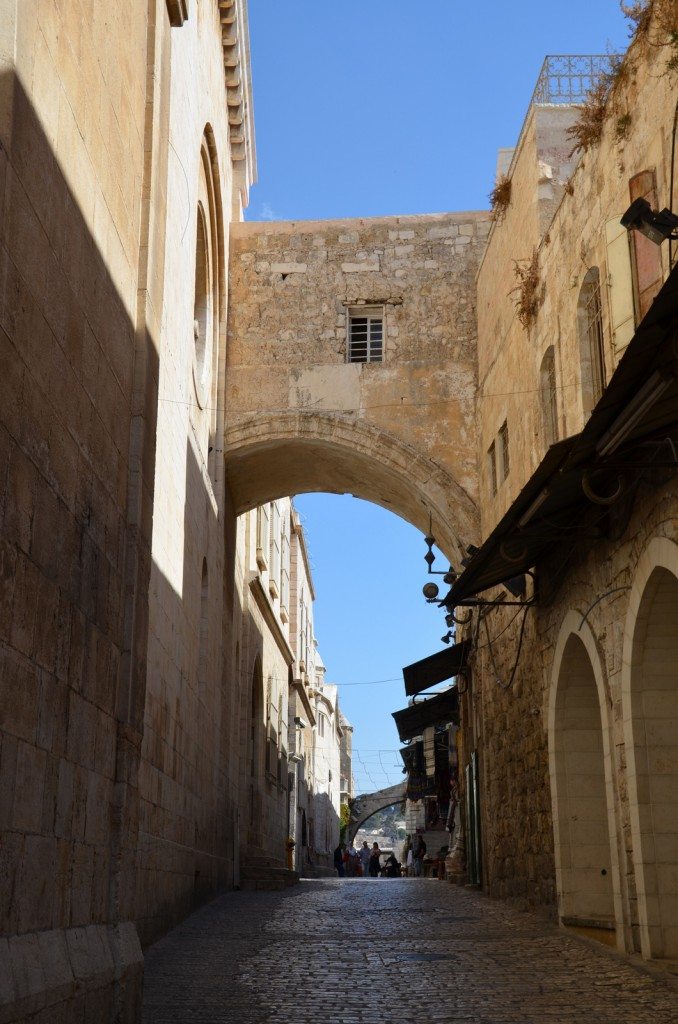
The so-called Ecce Homo arch, a triple-arched gateway, built by Hadrian as the entrance to the eastern Forum of Aelia Capitolina. Photo © Carole Raddato
JK: What surprised you the most as you visited and toured Israel? How did it compare to other countries that you have visited for Following Hadrian?
CR: On the day I arrived in Jerusalem (Wednesday 22nd October 2014), a rare find of historical significance was unveiled and displayed to the public outside the Rockefeller Museum (I urge everyone to visit this museum) by the Israel Antiquities Authority: a large slab of limestone engraved with an official Latin inscription dedicated to Hadrian. How fortunate was I? The fragmented stone, roughly a meter wide, with Latin text inscribed in six lines, might have been part of a monumental arch dedicated to Hadrian in 130 CE in honor of his imperial visit. Researchers believe this is among the most important Latin inscriptions ever discovered in Jerusalem and may shed light on the timeline of Jerusalem’s reconstruction. Their analysis revealed that this inscription is the right half of an inscription discovered nearby in the late 19th century CE by the French archaeologist Charles Clermont-Ganneau. The two slabs are currently on display in the courtyard of the Studium Biblicum Franciscanum Museum.

Bronze statue of Hadrian, found at the Camp of the Sixth Roman Legion in Tel Shalem, 117–138 AD, Israel Museum. Photo © Carole Raddato
I must say that I was totally spoiled with Hadrianic stuff in Israel, probably more than in any other country outside Italy with the exception of Greece maybe. The magnificent bronze statue of Hadrian can been seen in the Israel Museum in Jerusalem. It was found by chance by an American tourist in Tel Shalem – the camp of the Sixth Legion – (Beth Shean Valley) in 1975 CE while searching for ancient coins with a metal detector.
There are several other inscriptions dedicated to Hadrian that have been discovered in Israel, some are still attached to the Caesarea aqueduct that Hadrian rebuilt when he visited the port city in 130 CE.
And last but not least, in 130 CE, on his grand tour of the eastern part of the Roman Empire, Hadrian visited Jerusalem and renamed it Aelia Capitolina. Aelia is derived from the emperor’s family name (Aelius, from the gens Aelia), and Capitolina refers to the cult of the Capitoline Triad (Jupiter, Juno and Minerva). If you look around, you will see that the old city of Jerusalem is scattered with Hadrianic vestiges.
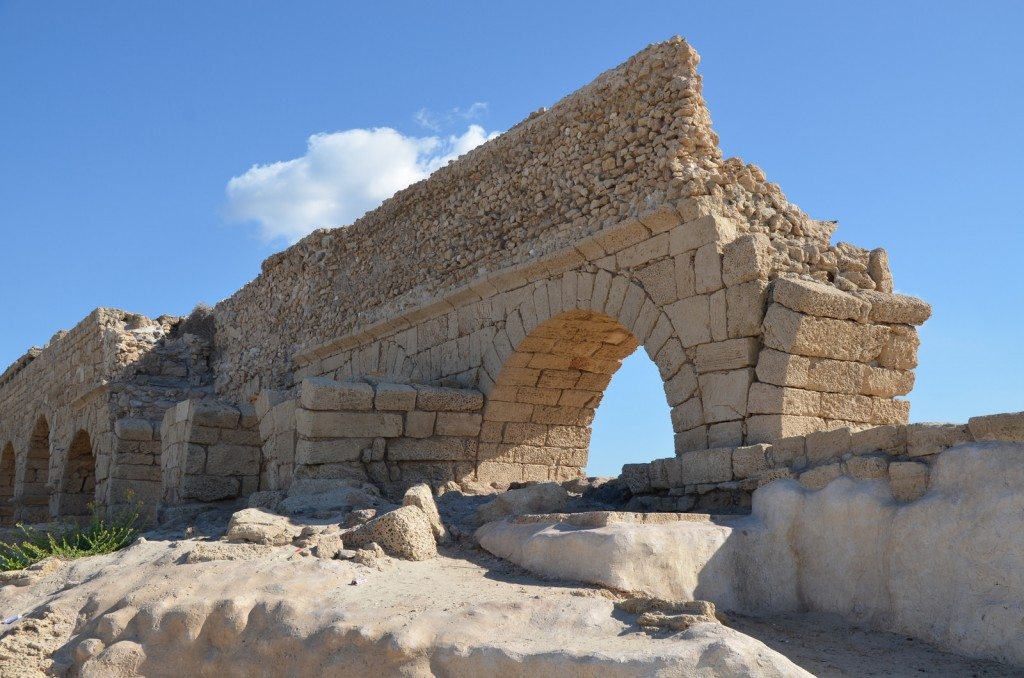
A portion of the high level aqueduct of Caesarea showing the two stages of construction (Herod & Hadrian), Caesarea Maritima, Israel. Photo © Carole Raddato
JK: How do you finance your trips? Work along the way, live solely on savings or go back home to work and save up?
CR: “How can you afford to travel so much?” I often get this question and I tend to answer it individually. Let me begin by saying that I am not rich and that I do have a job! I am a data analyst, working as a freelancer for a media company based in London. This allows me to work from anywhere in the world (as long as I have internet access) but I mainly work from home.
I work throughout the year and I take about five to six weeks holiday every year (one week in February, about ten days at Easter, one week during the Summer period and one week in October plus a couple of weekends on bank holidays). However, the main disadvantage of being self-employed is that I am not getting paid when I go on vacation. I think the main reason why I can afford to travel is because I have no major financial commitments (no children, no mortgage, no car). Also I think it’s about how much you prioritise travel. I have chosen to make travel my priority. I do not use my savings to travel, my revenues and those of my partner are sufficient to fund the cost of travelling but we always make sure we stay within budget (under €2,000 for one week for two, all expenses included).
JK: How much did your trip cost you in total? How did you manage to keep the price so low?
CR: We went slightly over our budget as we spent around €2500 euros in total for two travellers.
Flights: €800 – Hotels 7 nights: €600 – Car (rental + GPS + petrol): €480 – Sites & museums: €300 – Food: €350.
We tried to keep the price low but we knew that we were going to have to spend a little more cash than we would have on the average trip. Our daily budget in Israel was around €100 per day for two, depending on the number of sites/museums visited. When it comes to food, I found that eating out was relatively affordable. We often opted for small restaurants specialising in Middle Eastern food; hummus with fresh pita, falafels, tabbouleh and a selection of meze salads. This usually kept our meals anywhere between €15-20 (for two). We probably spent more on dinners when we went to proper restaurants and had international cuisine rather than local cuisine. Talking about local cuisine, if you happen to visit Tiberias, make sure you stop at one of the restaurants by the Sea of Galilee where you can eat St Peter’s fish. St. Peter’s fish is so-called because it is the very fish that swam in the Sea of Galilee when Jesus called Peter away from his nets to become a “fisher of men”. St Peter’s fish is usually served with French fries. It’s quite an expensive fish if bought outside of Israel so do not miss this opportunity, and it’s delicious!
JK: For those wishing to learn more about the sights and sounds of Israel, what blogs or books do you recommend?
CR: While preparing the trip, I came across a few interesting sites and blogs packed with images and useful information.
I also bought the book “Alexander to Constantine: Archaeology of the Land of the Bible” (Amazon) whose authors, Eric M. Meyers and Mark A. Chancey, re-narrate the history of ancient Palestine based on recent archaeological research. The book is richly illustrated and has numerous maps and drawings. Another essential book is “The Holy Land: An Oxford Archaeological Guide”.
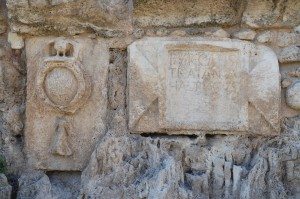
Inscription dedicated to Hadrian, from the High Level Aqueduct of Caesarea at Beit Hananya, with emblem depicting the 10th legion. Photo © Carole Raddato
JK: Lastly, what is your #1 advice for those wanting to travel on a budget and don’t know where to start?
CR: When you travel a lot and are constantly moving, like I do, it is not easy to anticipate the length of each stay; how long will I stay in this area, how many nights should I book in this hotel? After my itinerary map is finished I always use booking.com to look for accommodation. I have been using the site for so long now that I have unlocked the Genius status. As a Genius traveller, I get private genius rates, an extra 10% off select properties around the world. They have a big coverage of hotels so you can pick the right price range. You can have all your bookings in one place and if needed you can cancel or modify your bookings at no cost (unless you booked a non-refundable room). Our daily budget for accommodation is between €50 and €70. As a couple we never stay in hostels but rather in hotels where we can have a double room with ensuite bathroom.
With regards to car renting (we always travel by ourselves) I use exclusively rentalcars.com. The booking is easy and you can pick the right car for your trip and even choose the car rental company. I think you get cheaper deals than when you book directly with the car rental companies and after several bookings Rentalcars.com consider you as a “valuable customer” which can be very helpful in case of any problem when picking up your car (which happened to me when I had to cancel a booking at the very last minute).
For me it’s very important to make the booking process easy and at the same time try to get good deals. However, with my partner being a teacher, it is impossible for us to avoid the holiday season or to avoid flying on Fridays and Sundays (the cheapest days for flying tend to be Tuesdays and Wednesdays). Flying during the holiday season is expensive making it difficult to get good deals on flights, although we tend to book them early, often several months in advance (the closer you get to the trip, the higher the price will be).
Ms. Carole Raddato is a data analyst specialising in media and the music industry. But since 2006, she has been travelling and exploring the ancient world. Through her blog Following Hadrian she provides history enthusiasts with beautiful images and insights from the places she travels to. Her favourite pastime is to follow in the footsteps of the Roman Emperor Hadrian and visit the places he once saw.
All images featured in this interview have been attributed to their respective owners. Images lent to the Ancient History Encyclopedia by Carole Raddato have been done so as a courtesy for the purposes of this interview. Unauthorized reproduction is strictly prohibited. All rights reserved. © AHE 2015. Please contact us for rights to republication.
